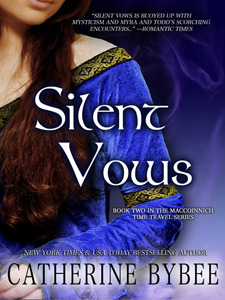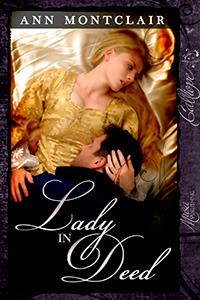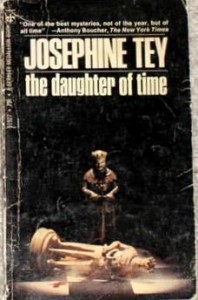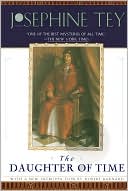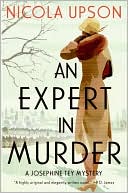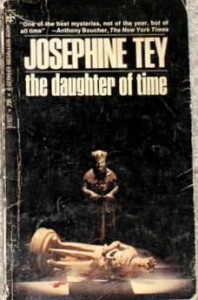 Format read: ebook purchased from Amazon and paperback purchased a long time ago
Format read: ebook purchased from Amazon and paperback purchased a long time agoFormats available: Trade Paperback, ebook, audiobook
Genre: Mystery
Series: Inspector Alan Grant #5
Length: 175 pages
Publisher: Scribner
Date Released: December 1, 1951
Purchasing Info: Publisher’s Website, Goodreads, Amazon, Barnes & Noble, Book Depository
Without leaving his bed, Inspector Alan Grant investigates the evidence in the case of Richard III & the Princes in the Tower, arriving at a convincing solution by means of acute historical detection. A critical piece of evidence in this unabashedly Ricardian tale is the Bill of Attainder brought by Henry VII against Richard III, which makes no mention whatsoever of the princes—certainly suggestive to Grant of their being alive at the time.
Critics point out that this is a work of fiction. Rightly so. Despite that, in the decades since it was printed it’s turned many of the idly curious to devout Ricardianism. Anthony Boucher called The Daughter of Time “one of the permanent classics in the detective field”. Dorothy B. Hughes termed it “not only one of the most important mysteries of the year, but of all years of mystery”.
The title of the novel is taken from Bertolt Brecht’s play Life of Galileo, in which the eponymous hero observes: “Truth is the daughter of time, not of authority.”
My Review:
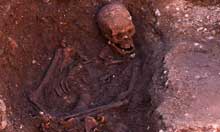 The last Plantagenet. The last King of England to die in battle. And until last week, very nearly the last King of England whose earthly remains were supposedly missing. (I’ll get back to that)
The last Plantagenet. The last King of England to die in battle. And until last week, very nearly the last King of England whose earthly remains were supposedly missing. (I’ll get back to that)
When the experts identified the skeleton under the car park (a car park!) in Leicester as belonging to Richard III, like so many, I went back to Josephine Tey’s The Daughter of Time. Her book, the story of a laid-up Detective Inspector investigating historical mysteries to keep from going spare, was my first real introduction to Richard.
 It left a life-long impression. On my first trip to England, I visited Bosworth Field, the site of Richard’s final battle. (This was not easy on a rail-pass, the train didn’t go to Market Bosworth, and it was not much of tourist destination.)
It left a life-long impression. On my first trip to England, I visited Bosworth Field, the site of Richard’s final battle. (This was not easy on a rail-pass, the train didn’t go to Market Bosworth, and it was not much of tourist destination.)
But Tey’s book, it lived in memory. My copy is so old that I purchased it new for less than a dollar. It’s yellow and brittle at the edges. I wondered if the story would hold up.
Written in 1950, I couldn’t help but wonder a bit about the framing story. Her Inspector Grant has a broken leg, and is in hospital for 6 weeks flat on his back. No television in 1950, and seemingly no radio.
He’s also not drugged out of his noggin. His hands are free, it’s his legs that are non-functional. Yes, he could read a book, and people bring him lots. In fact, his comments on the best sellers of the day are just as sharp and biting as ever.
A few bits rankle to a 21st century reader. Women are nurses or in service occupations, except for Grant’s actress friend Marta Hallard. Men are police, doctors, researchers.
When Grant becomes cranky in his extreme boredom, Marta charms a friend at the Victoria and Albert Museum to create a packet of pictures that illustrate famous historic mysteries.
 Grant’s fascination with faces causes him to make a mistaken identification. He finds one face from the pile, and thinks the man should be a judge or an official of some kind. Instead, the man in the portrait is someone who has gone down in history as the quintessence of evil: Richard III.
Grant’s fascination with faces causes him to make a mistaken identification. He finds one face from the pile, and thinks the man should be a judge or an official of some kind. Instead, the man in the portrait is someone who has gone down in history as the quintessence of evil: Richard III.
The story is Grant’s academic investigation, all conducted from the hospital while flat on his back, into the case against Richard. He’s forced to use other people to do all his legwork and research at a time when there was no internet. He doesn’t even seem to have had a phone in his room.
What Grant (and Tey) create is a fascinating look at how history gets made.
I read this the first time in high school, and found that the unforgettable lesson. Whether you finish the book believing that Richard is innocent or guilty, what I was left with was the absolute conviction that history is written by the victors. (It helps to have someone like Billy Shakespeare as your press corps)
Escape Rating A+: There’s always a fear that when you pick up a beloved classic that you haven’t read in a while, that it won’t wear well. Tey was smart to keep the framing story of The Daughter of Time to a minimum–it doesn’t intrude on the historical mystery enough to make the out-of-date details of 1950 jar against the historical discovery, which does not get old.
Just as it did the first time (and the second, third, and possibly fourth) reading The Daughter of Time made me THINK. First about how history is made and shaped by what is recorded. The word history is two words, “his” and “story”. The tale always changes based on who tells it. Or, as one of my former supervisors once put it, “the person who writes the minutes of the meeting controls history.”
I also paid a lot of attention to what people did, and not just what they said. It was a historical lesson learned about what constituted a primary vs. a secondary source that I never forgot when I studied history in college.
It was also fun to see the historic mystery as a police case instead of as dry history. Simpler questions like “where was so-and-so on the night of the king’s death?” or the old chestnut “who benefits?” were very relevant, even when documents were being “interrogated” instead of people.
If you like mysteries, and you’ve never read The Daughter of Time, do. It’s a treat. Especially if you read the fuss about finding Richard III’s bones and wondered what all the fuss was about. Josephine Tey wrote the best explanation you could ever find.
And what I wrote a bit earlier about King’s bones that have or have not been found? One tiny detail. About the “Princes in the Tower” that Richard, or someone, had killed. Two skeletons were found in the Tower of London in the 1600’s that were decided on not much evidence must belong to the “Princes in the Tower”. In spite of repeated requests, the Church of England is refusing requests to have the bones DNA tested. They’re not sure what to do if the bones turn out not to be the Princes after all!



